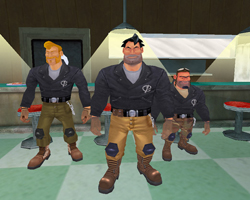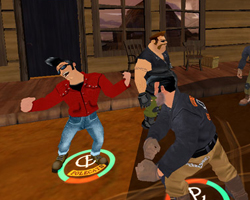Missing Pressumed? (II)
The second part on our cancelled games article series focuses on the true story of Full Throttle 2, in both of its versions, backed with declarations byt the first Art Director of the project: Bill Tiller
# Paco García |

As production of the game continued, Larry Ahern, who, like many creatives from the company, had been trained in the adventure genre, felt uncapable to deal with a title so distant from its standards. As much experience he had as an artist and designer, he had its hands tied up: “Larry and I”, Tiller comments, “had worked together on Curse of Monkey Island and I love Full Throttle and the art and I was good friends with Peter Chan, the original art director on it. I pumped his brain over the phone for as much information about Full Throttle as possible, and studied his Full Throttle art like a mad man. So we were kind of the perfect pair for it. But Larry had not made a 3D, nor an action game, before so management was concerned”.
Given this crossroads, the Californian company decided to incorporate new personnel to the project; people more willing to take part on products like this one: “Management changed. Out went Steve Daughterman and in came Randy Breen, from EA. We were all excited by Randy because he had worked on Road Rash, a great motorcycle combat game”.

The story of Payback revolved around the gangs of bikers and truckers, who did not care for each other and were old rivals for supremacy of the highways, but they would be forced to unite to fight a political initiative to remove all roads and replace them with hover pads, thus making trucks and motorcycle useless and obsolete. This union would have been under the leadership of the wise Father Torque, the retired leader of Ben's gang, the Polecats. Fully aware that these protests would have a huge impact on the media, the dark bigwigs of Washington, driven by dark interests, would then prepare their move with the intention of silencing any opposing voices. Ben’s estranged brother, now a political character assassin working for the governor, warns him about this: they plan on eliminating Father Torque’s ability for oratory, by paying the ruthless gang of Rottwheelers to assassinate him at a secret biker/trucker rally in the old mining town of Coyote Spit.
The first mission in the game would have been to stop the assassination, then the next missions included uncovering the assassination plot, and then saving all the truckers and bikers who were arrested by the Senator at the rally. They were going to be killed in an “accidental” explosion at a gas tower, which was looming over the biker/trucker prison compound.
As you can see, the plot is similar to that of Full Throttle which so many people loved: once again it was the greedy suits who threatened the survival of the “highway races”, but with the approach this Full Throttle was given, we reckon that was the only simmilarity with the original game. This plot, besides, was constantly being changed, making it loose more and more consistency in its “adventure part”. Bill Tiller remembers: “New characters were going to be introduced, and possibly a new love interest in the form of a persistent reporter, and also Ben's brother. I say possibly, because the story was in constant flux. A few old characters were also going to reappear like Ben's gang, Father Torque and a cameo by Maureen … The story was in constant flux”, he follows, “because Randy Breen wanted it changed all the time. But I felt he could have been more helpful by actually playing Full Throttle again, and getting us a script writer. But he did not, so we spent a lot of time reworking the story over and over”.

The transformation into Full Throttle 2: Hell on Wheels
The game continued its development although, as we can see, it had several difficulties as the expectations were huge and the approachs taken were not as right as they should. Instead of trying to make a mends, Randy Breen did not seem to have towards his employees the confidence they deserved as the experienced professionals they were, and constantly changed the development team, as Tiller reflects: “[I] suspect he lost confidence in our ability to design a game, and was looking to have Sean Clark take over very early on. I could be wrong though. Sean has a history of taking over games and game franchises and getting them out the door”.
Permutations on the team, squabbles between the people in charge, and disagreements and differences inside the company, caused Payback to fall apart: “After six months of going around in circles Larry left LucasArts to go work for Microsoft. I was asked to stay on as Art Director, but Sean Clark and I had already worked together and he and I were not getting along too well lately, so I decided to follow Larry up to Seattle and worked at ArenaNet on Guild Wars”.
Continues on next page
Page 2 of 3
« Previous | 1 | 2 | 3 | Next »
